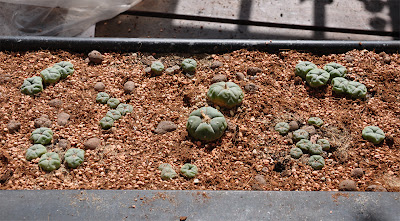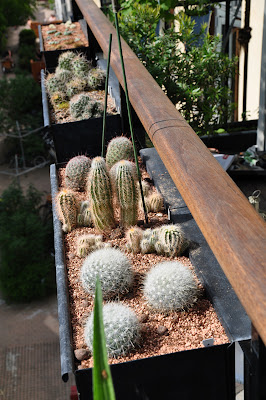
Snow covered cacti growing in window boxes
As mentioned in an earlier post I'm experimenting with growing peyote (and other cacti) outdoors on my balcony. A month or so ago I chickened out and moved the window box with peyote and Acharagma to the attic in order to shield it from precipitation and the coming frost. Today I'm glad I did as the balcony (and the flower boxes with it) has been completely covered in snow for the last couple of days - and I'm not sure if that would become the peyote plants well.

Echinocereus triglochidiatus covered by snow (with E. reichenbachii in the background)
I'm pretty sure that the hardy Echinocereus triglochidiatus will make it through the outdoor winter experience, and I'll also put money on the Escobaria vivipara (Alberta, Canada) and Escobaria missouriensis (SB204; Mesa County, Colorado) plants as they have already survived a winter outdoors, but I have my doubts about the Echinocereus reichenbachii plants as this is the first time I grow them under such extreme conditions.

Snow covered Mammillaria grahamii
Other doubts are regarding the Mammillaria grahamii (SB 1860; Steins, New Mexico, USA) and Mammillaria senilis (ROG 214; Tecorichi, Chihuahua, Mexico) plants as I'm very unsure if they are able to survive conditions like this. We'll know come spring.

Snow covered Mammillaria senilis
Thursday, January 30, 2014
Snow covered cacti on the balcony
Friday, September 13, 2013
Late-flowering peyote cactus
We are closing in on autumn in Denmark and the weather report promises heavy precipitation the coming days. Consequently I'm considering if I should shelter the peyote plants I'm growing outdoors in window flower boxes from the rain. Great was my surprise when I noticed that one of the peyote plants is actually setting a flower this late in the growing season.

Late-flowering peyote cactus
I doubt this flower will ever unfold - the weather is overcast tomorrow and after that it rains for a week - so I snapped the above picture showing the budding plant basking in the last rays of sun.
... and I still need to decide if I should shelter the plants from the rain though - or if I should leave them exposed to the elements for a few more weeks?
Friday, August 02, 2013
Peyote plants maimed by birds
As mentioned in the post "Growing peyote (and other cacti) on the balcony" I'm experimenting with growing peyote cacti in window flower boxes on my balcony.
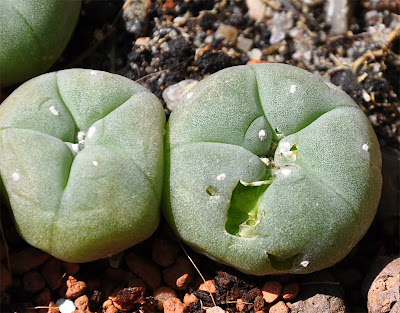
Peyote cactus maimed by a bird
The plants are thriving outdoors basking in the Danish summer sun, but several times I've had to chase blackbirds and pigeons off of the flower boxes. Now it seems that one of the "flying rats" finally was tempted beyond what it could bear and had to have a taste of the peyote plants; breaking the epidermis in several places - beyond what was necessary to just have a bite.

Bird damaged peyote in flower box
I've always found the intrusive pigeons annoying but now I consider them pests.
Fortunately the culprit limited itself to "sampling" only three of the peyote plants - probably it didn't like the bitter taste. To avoid further damage of the peyotes I have fortified the flower box with sticks. Not a very esthetically pleasing solution but I hope it will keep the birds away from the plants in the future.

Fortified flower box with peyote and Acharagma
Tuesday, June 25, 2013
Growing Echinocactus polycephalus and Echinocactus horizonthalonius from seed
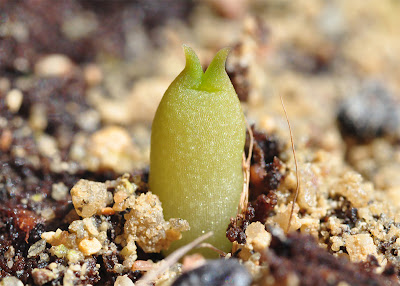
Immaculate Echinocactus polycephalus seedling
Back in 2009 I bought 100 seeds each of Echinocactus polycephalus (SNL 91; Las Vegas, Nevada) and Echinocactus horizonthalonius (SB 409; Shafter, Texas) from Mesa Garden. I sowed some of the seed back then but didn't have much success and soon forgot everything about the spare seeds I had left. That is until a few days ago :-)
As the seeds, in my (limited) experience, are extremely hard to germinate I decided to scarify them with a scalpel. You have to be very careful not to damage the embryo when making shallow cuts in the testa (seed coat) with a scalpel - and manually scarifying 80-some tiny seeds is an extreme test of your patience. After brutally cleaving several seed embryos I settled for chipping away at the protrusion of the hilum - this allowed me to break of small pieces of the testa without damaging the embryo within. The scarified seeds were left to soak in water for a few hours - I added the smallest tad of detergent to remove the water surface tension and allow for more efficient soaking of the seeds.
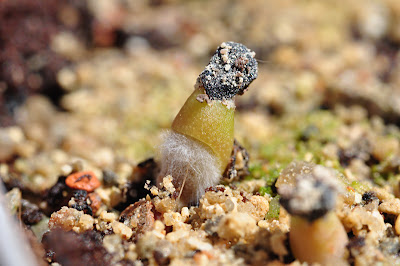
Echinocactus polycephalus seedling in the process of damping off - killed by mold
A few days after sowing the seeds several seedlings have surfaced. Unfortunately a few of them are already showing "rusty" spots and some has completely damped off, killed by mold. Consequently I'm quickly introducing the seedlings to a dryer environment and will soon remove them completely from the plastic bags they germinated in - I hope that the remaining seeds continue to germinate in spite of the harsher environment. Steve Brack's encouraging notes regarding this type of cacti reads: "rot easily, right after germination: not too wet, dry air and stronger light."

Etiolated Echinocactus polycephalus seedling, red from the sun
Some of the seedlings seem to have a hard time ridding themselves of the spent seed coat. They grow slightly etiolated and don't develop much chlorophyl in the deep shade of the testa - consequently they turn all red when exposed to the sunlight.

Echinocactus polycephalus seedling showing "rusty" spots
As usual I'm germinating my seeds in pots placed in clear plastic bags. As it's early summer I'm experimenting with germinating the seeds outdoors on the balcony - the daytime temperatures are around 20 C (68 F) with pleasantly cool nights. The temperature inside the bags off course grow hotter as they are exposed to sun during the day.

Bags containing Echinocactus, Ariocarpus, Aztekium, and peyote seedlings
With time I hope that my seedlings grow to look like this beautiful cluster of Echinocactus polycephalus (var. xeranthemoides) that overlooks the Tonto Platform in the Grand Canyon

Echinocactus polycephalus (var. xeranthemoides) overlooking the Tonto Platform
The Echinocactus horizonthalonius seedlings seem somewhat easier and more "well behaved". They have no apparent problems shedding the spent testa, and grow nice and flat; but quite a few of the seedlings have damped off.

Echinocactus horizonthalonius seedling

Echinocactus horizonthalonius seedling ridding itself of the spent seed coat
It's probably not going to be in my lifetime, but I hope my seedlings will grow to look like the fine specimen featured at the Chrudimský Kaktusář web site:

Flowering Echinocactus horizonthalonius
Saturday, June 08, 2013
Growing peyote (and other cacti) on the balcony
40 peyote cacti growing in a window flower box
For the last many years I've experimented with growing peyote, Ariocarpus, Leuchtenbergia, and the likes in an unheated coldhouse in Denmark. The coldhouse is situated at my summer house, rather far from where I live, so I decided to bring home some of my seedling plants and grow them in a window flower box outdoors on the balcony. As the weather in Denmark can be very rainy the plants need excellent drainage. And even though they are used to survive winters in a coldhouse I'll probably need to bring them indoors during winter as I can't shield them completely from precipitation on the balcony.
Flower box planted with peyote and Acharagma
I waited for a sunny period (and a ditto long term weather report :-) before planting a window box with 40 peyote plants and a handful each of Acharagma aguirreana and Acharagma roseana plants.
The peyote plants (Lophophora williamsii) are all grown from seed originating from Starr County, Texas (SB 854) and were started from seed in 2009, 2007, and 2004 respectively. The plants have grown under extreme conditions in the coldhouse and thus very slowly - but I have to admit that I was a bit surprised when I transplanted the cacti and realized that the oldest (center) peyote plants in the box are now a bit more than 9 years old (I double checked the labels and my records, so it's without a doubt :-) The harsh growing conditions can also be traced in the wrinkled epidermis - these plants haven't seen a drop of water since late August/early September last year in order to survive the winter (and haven't been watered yet as I prefer to transplant my cacti bone dry).
Both Acharagma species were started from seed in spring 2009.
Drainage layer of Leca pebbles
I have never grown this type of cacti in window flower boxes before and was very much in doubt of what type of soil to use.
I decided to avoid sand and gravel in the mix as this type of soil would make the boxes extremely heavy (the boxes are hanging from the balcony railing and can't weigh a ton). Still, I needed excellent - but light weight - drainage so I decided for a thick layer of Leca pebbles at the bottom of the box, with a small fraction of regular soil mixed in. Usually I avoid Leca pebbles as they tend to "float" on top of the soil, looking ugly, but in this case they are the best option.
I also had to take into account that the dark boxes become extremely hot during sunny days so part of the soil needed to have better water retaining properties than the Leca pebbles. My solution was to use a top layer consisting of burnt moler cat litter and coir (a natural fibre extracted from the husk of coconut) - both are able to retain water but don't get soggy and waterlogged.
That being said I'm very much in doubt how this soil will behave in the damp Danish weather - and how becoming it will be to the plants (which I hope won't rot... but I'm sure time will tell :-)
Flower box planted with Echinocereus reichenbachii and Mammillaria
Another flower box was planted with Echinocereus reichenbachii originating from material I collected in the Wichita Mountains Wildlife Refuge back in 2007 plus a few Mammillaria grahamii (SB 1860; Steins, New Mexico, USA) and Mammillaria senilis (ROG 214; Tecorichi, Chihuahua, Mexico) plants bought from Kakteen-Haage.
I don't have much experience with growing Mammillaria species but selected these plants for their ability to tolerate cold conditions - and also for their beautiful flowers of course :-) One thing I learnt the hard way is that the fish hook spines of the Mammillaria plants behave like velcro when the plants get too close to each other, i.e. you should be very careful when planting several plants in the same container.
Three cacti window flower boxes on a row
I now have a total of three window flower boxes planted with cacti on the balcony; the two covered in this post plus the box planted with Echinocereus triglochidiatus, Escobaria vivipara (Alberta, Canada), and Escobaria missouriensis (SB204; Mesa County, Colorado). The latter box was planted last year and wintered outdoors on the balcony.
Sunday, May 19, 2013
Sunburned San Pedro cactus (Trichocereus pachanoi)
I keep a few mature Trichocereus plants that are moved out on the balcony come spring. While the Trichocereus peruvianus (Peruvian Torch cactus) and Trichocereus bridgesii plants usually take the transition to being exposed to the elements in stride, I always have to look out for my Trichocereus pachanoi (San Pedro cactus) not to get sunburned. Like in humans sunburn in cacti is the result of an inflammation/damage of the epidermis caused by excessive exposure to ultraviolet (UV) radiation from sunlight; typically most severe in new growth.

San Pedro cactus developing a sunburn
Consequently I aim to introduce the tender Trichocereus pachanoi gradually to full sun. This spring I made sure to place the San Pedro in an area that lies in shade most of the day. I even heeded the weather reports and moved the plants indoors on sunny days. Still the San Pedro is developing a sunburn in the new growth area facing the sun - interestingly it doesn't seem to get sunburned at the growing point at the tip but always a bit down the side from it, probably because of the steeper angle of incidence of the sun rays and UV radiation.

Undamaged, bright green new San Pedro growth
More severe burns turn into unbecoming, hard tan scars as illustrated by the below picture of last years burn (where I thoughtlessly moved the plants out and placed them in a sunny spot without observing them for a couple of days).

Trichocereus pachanoi with sunburn from last year
A light sunburn can be outgrown but the hard scars are permanent.
I'll end this post on a more positive note with the image below of a Ginkgo biloba happily setting new leaves :-) The Ginkgo biloba grows on the balcony year-round.
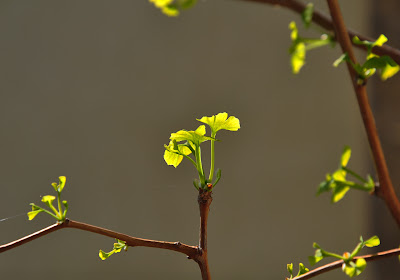
Ginkgo biloba ushering in spring
Sunday, January 27, 2013
Snow covered cacti on the balcony

Escobaria vivipara with a light snow cover
I’m fascinated by the ability of certain cacti species to survive even quite extreme freezing conditions. A fascination that is probably rooted in my childhood belief that all cacti were heat craving desert dwellers that would succumb to subfreezing temperatures - great was my surprise the first time I saw pictures of a cactus covered in snow.

Echinocereus triglochidiatus var. mojavensis sprinkled with snow
I live in a condominium and the only possibility for pursuing my interest in growing frost tolerant cacti outdoors - apart from the bed of winter-hardy cacti at my summerhouse - is to grow cacti in flower boxes on the balcony.
For several years I have successfully grown Echinocereus triglochidiatus (claret cup hedgehog cactus) outdoors (year-round) at my summerhouse in the northwestern part of Denmark - inspired by this I acquired a few E. triglochidiatus var. mojavensis (DJF1273; North of Inyo County, California) plants for my flower boxes a couple of years ago and they are also doing great.

Escobaria missouriensis in the snow
The well-being of the Escobaria species are of greater concern to me. The Botanical Garden of Copenhagen attempted growing Escobaria in their outdoor cactus bed but they all perished. My plants still seem to be weathering it out here in Copenhagen but I’m concerned that the continuous frost-thaw cycles will expose the plants to killing moisture.
Denmark has been frost-bound for several weeks now with the plants seeing temperatures as low as -10 C (14 F) (this is nothing for Escobaria vivipara which is known to have survived extreme temperatures as low as -35 degrees C) but the frost now loosens its grip again and it has started to rain, soaking the flower boxes that are still frozen solid. I hope that the light shelter provided by the balcony on the floor above will keep the plants from getting too wet - if not, I reckon the rot will soon show in the coming period of relatively warm and humid weather.
The beehive cactus species I’m growing in flower boxes on the balcony are Escobaria vivipara (Alberta, Canada) and Escobaria missouriensis (Mesa County, Colorado; SB204)

Flower box with Escobaria and Echinocereus cacti in the snow
This coming season I plan to grow peyote cactus in outdoor window boxes as well - but I don’t expect peyote to cope well with the Danish winter so the plants will need to be wintered in the attic.
Below are a few pictures of the balcony grown Escobaria plants during summer - what a happy flowering bunch :-)

Flowering Escobaria vivipara (Alberta, Canada)
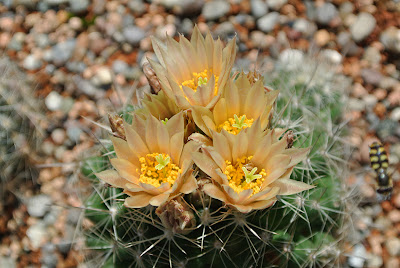
Flowering Escobaria missouriensis (Mesa County, Colorado; SB204)
In relation to the two above images, the previous post featured a high-speed video showing the flower fly hovering above the Escobaria vivipara cactus.
Monday, January 21, 2013
Hoverfly visiting a flowering Escobaria vivipara (Alberta, Canada) cactus
While preparing a post on the cold-hardy cacti I'm growing in flower boxes on my balcony I stumbled upon this high-speed video I shot last summer. The video shows a hoverfly visiting a flowering Escobaria vivipara (Alberta, Canada).
Hoverflies, sometimes called flower flies or syrphid flies, make up the insect family Syrphidae - a group of superbly beneficial insects, the adults being pollinators and the hoverfly larvae being predators of aphids and other damaging insect pests and their larvae. The coloring and movements of most species mimic bees or wasps giving them some protection against being eaten by birds.
I’m by no means an entomologist and to my untrained eye the flower fly in the video looks like a Scaeva selenitica (a common European species of hoverfly) with its three pairs of yellow comma markings on the abdomen. If you are an expert on insects and recognize the fly I would be happy to know the exact species.
If the above video doesn’t embed properly you can open it in a separate window by clicking the image below.

Hoverfly (Scaeva selenitica?) visiting flowering Escobaria vivipara (Alberta, Canada)
The high-speed video was filmed at the end of June 2012 using a Nikon 1 J1 camera.
All Time Most Popular Posts
-
Lophophora williamsii (peyote) populations have diminished in large areas of South Texas where peyoteros harvest the cactus for ceremonial ...
-
On various occasions I've been asked what growing media I'm using for my cactus plants. I don't have a set soil mix recipe as su...
-
Below is a list of retailers/nurseries selling cactus seed and plants. I've only listed vendors I've done business with. If you ar...
-
Most cacti are easily grown from seed - and with a little patience and care they can be grown into beautiful plants. Lophophora williamsi...
-
In last month’s post on the troubled Texan peyoteros I referred to Anderson’s article on the peyote situation in Texas. Given the importanc...
-
Yet another slightly off topic and probably not entirely politically correct post, but I couldn’t help noticing the similarity of my monstr...
-
Flowering stand of San Pedro cacti (Trichocereus pachanoi) To me the main draw of the San Pedro cactus ( Trichocereus pachanoi (syn. Ech...
-
In the June 2008 issue of the Cactus & Co magazine Jaroslav Šnicer, Jaroslav Bohata, and Vojtěch Myšák described a new Lophophora spec...
-
There seems to be an increased focus on the alarming Texas peyote situation. A couple of weeks ago the Houston Press published a mournful, i...
-
I spent two weeks working in Delhi, India during January. I had one weekend off and had planned to spend it in Delhi at my own leisure, but ...
